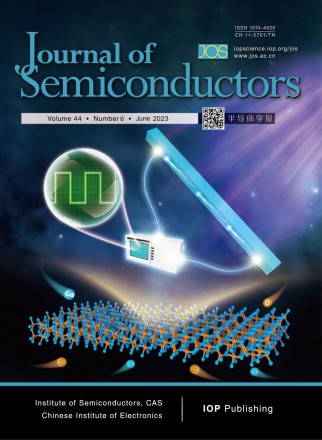《Journal of Semiconductors期刊》CSCD期刊 统计源期刊
Journal of Semiconductors《Journal of Semiconductors》杂志是CSCD期刊统计源期刊、,创办于1980年,发行周期是月刊。综合影响因子0.17,中国科学院半导体研究所;中国电子学会主办,中国科学院主管。主要栏目有研究快报、研究论文、研究简报、技术进展等。
-
主管单位:中国科学院
-
ISSN:1674-4926
-
主办单位:中国科学院半导体研究所;中国电子学会
-
CN:11-5781/TN
-
审核时间:1-3个月
-
创刊时间:1980
-
全年订价:¥ 768.00
-
发行周期:月刊
杂志简介
《The Journal of Semiconductors》published jointly by the Chinese Institute of Electronics and the Institute of Semiconductors, a branch of the Chinese Academy of Sciences, covers the latest achievements and developments in the field of semiconductors and related science and technology.
《The Journal of Semiconductors》distinguishes itself from academic journals of physics and electronics in its being an interdisciplinary academic journal involved with the fields of both physics and information.
期刊须知
1. By submitting a manuscript, the authors affirm that the manuscript has not been published previously and is not currently under consideration for publication elsewhere. The authors also affirm that the manuscript does not contain the content of the results of others. Copyright of the manuscript including CD-ROM, Internet and other media is assigned to the editorial office of JoS from the date on which the manuscript is accepted for publication.
2.Manuscript must be written in English, and should be neatly typed, double spaced, with A4 paper size.
3.Manuscript should have a clear point of view and reliable data, and should be concise and focused. If the manuscript contains similar or closely relevant contents to the published papers, the authors should show them in references.
1)Title, Author, Institution, and Abstract
* Title: The title should be concise, precise but informative, and should not be over 10 substantive words. * Author: The names of authors should be confirmed before submitting a manuscript and cannot be changed after submission. * Institution: The full name of the institution, the city where it is located, and the postal code are needed.* Abstract: The purpose, method, results, and conclusion of the research work should be briefly presented in third person. The abstract should not normally exceed 200 words. As the abstract is not part of the text, it should be complete in itself; no table numbers, figure numbers, references or displayed mathematical expressions should be included.
2).Key words and PACS or EEACC numbers
* Key words: Between 3 and 6 key words should be provided. * PACS or EEACC numbers: Between 1 and 3 numbers should be given.3). Foundation and Contract number:The supporting organization and contract number should be given.
4). Abbreviations, Acronyms, and Units of measure
* Abbreviations and Acronyms: All acronyms and abbreviations should be clearly explained when they first appear in the abstract or text. * Units of Measure: The SI system should be used, and all units used should be consistent throughout the manuscript.5). Figures and Tables
* Figures (Including photographs): Figures should be arranged sequentially with Arabic numerals, and should be clear, easy to read and of the best possible quality. The width of the figures should be not over 8 cm, and the lines must be smooth, clean and uniform. The tick marks on figure axes should point inward. Characters should appear as they would be set in the main body of the manuscript. Photographs should be in good contrast with details clearly distinguishable. We will normally use figures as submitted; it is therefore your responsibility to ensure that they are legible and technically correct. The use of colour in figures is freely available in the online version of the manuscript, but authors will be charged RMB 1 200 per colour journal page in the printed version.* Tables: Tables should be numbered serially and referred to in the text by number (Table 1, etc). Concise and precise three-line tables should be used.
6). References
References should be numbered consecutively, in the order in which they appear in the text, with square brackets enclosing the number. The information about the references cited should be provided in its entirety. References should not contain un-published data.
Normally, at least 15 references should be provided, among which at least 10 references should be published in the past 5 years.
期刊收录
期刊荣誉
数据分析
- 综合影响因子:0.36
- 期刊他引率:暂无
- 被引半衰期:暂无
- 平均引文率:暂无
立即指数
期刊他引率
立即指数:表征期刊即时反应速率的指标,即该期刊在评价当年刊载的论文,每篇被引用的平均次数。
期刊他引率:期刊被他刊引用的次数占该刊总被 引次数的比例用以测度某期刊学术交流的广度、专业面的宽窄以及学科的交叉程度。
影响因子:指该刊在某年被全部源刊物引证该刊前两年发表论文的次数,与该刊前两年所发表的全部源论文数之比。
影响因子
杂志发文量
主要发文机构分析
| 机构名称 | 发文量 | 主要研究主题 |
| 中国科学院 | 1375 | 半导体;激光;激光器;砷化镓;GAAS |
| 清华大学 | 433 | 电路;集成电路;CMOS;半导体;VLSI |
| 复旦大学 | 371 | 电路;硅;半导体;集成电路;CMOS |
| 北京大学 | 369 | 半导体;MOSFET;电路;硅;发光 |
| 中国科学院微电子研究所 | 256 | 晶体管;电路;SOI;HEMT;INGAP/GAAS_HBT |
| 西安电子科技大学 | 217 | 电路;晶体管;4H-SIC;集成电路;MOSFET |
| 浙江大学 | 208 | 单晶;直拉硅;硅;氧沉淀;硅单晶 |
| 东南大学 | 161 | CMOS;MEMS;感器;半导体;传感 |
| 南京大学 | 125 | 发光;光致;光致发光;半导体;硅 |
| 电子科技大学 | 123 | 击穿电压;LDMOS;RESURF;电路;耐压 |
相关杂志
-
Chinese Medical Journa...
主管单位:中国科学技术协会
-
Journal of Thermal Sci...
主管单位:中国科学院
-
Journal of Integrative...
主管单位:农业部
-
Journal of Systems Sci...
主管单位:中国科学技术协会
-
Journal of Beijing Ins...
主管单位:兵器工业总公司期刊办
-
Journal of Energy Chem...
主管单位:中国科学院
-
Journal of Computer Sc...
主管单位:中国科学院
-
World Journal of Gastr...
主管单位:山西省科学技术厅
-
Journal of Hydrodynami...
主管单位:中国船舶重工集团公司
-
Journal of Tropical Me...
主管单位:广东省气象局
-
Journal of Meteorologi...
主管单位:中国科协
-
Chinese Journal of Aer...
主管单位:中国科学技术协会
免责声明
本站合法持有《出版物经营许可证》,仅销售经国家新闻出版署批准的合法期刊,不是任何杂志官网,不涉及出版事务。本站仅提供有限咨询服务,需要用户自己向出版商投稿且没有绿色通道,是否录用一切以出版商通知为准。提及的第三方名称或商标,其知识产权均属于相应的出版商或期刊,本站与上述机构无从属关系,所有引用均出于解释服务内容的考量,符合商标法规范。本页信息均由法务团队进行把关,若期刊信息有任何问题,请联系在线客服,我们会认真核实处理。 若用户需要出版服务,请联系出版商,地址:北京市海淀区清华东路甲35号,邮编:100083。
